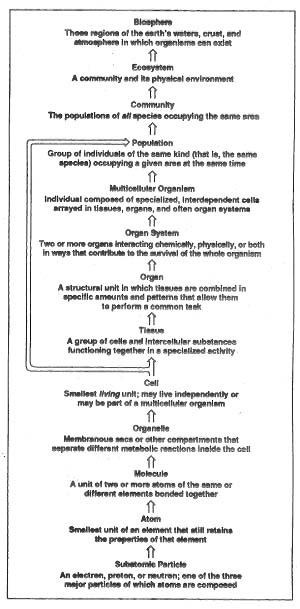Hierarchical Structure
Herbert Simon, a Nobel Prize-winning economist and pioneering cognitive scientist, wrote an article titled "The Architecture of Complexity" (Simon, 1962) in which he argued that all systems are hierarchical in structure.
By a hierarchic system, or hierarchy, I mean a system that is composed of interrelated subsystems, each of the latter being, in turn, hierarchic in structure until we reach some lowest level of elementary subsystem. (Simon, 1962)
Any system is made up of smaller parts. Furthermore, each part is composed of still smaller parts.
This can be called decomposability. That does not mean scientists can literally take anything apart and put it back together again, as was attempted with Humpty Dumpty. But it does mean they can analyze the system into parts, such as yolk, egg white, and shell, and then into smaller parts such as biomolecules.
Consider the human body. It is composed of organ systems such as the respiratory system, circulatory system, and central nervous system. Each of these contains organs, like the heart and the brain.
Organs have components called tissues. Tissues are composed of cells, which are composed of membranes, fluids, and organelles, which are composed of molecules, which are composed of atoms. Atoms are composed of subatomic particles, and so on, to the smallest measurable components.
The decomposability of systems is not exactly a new idea. It should be familiar to college students in a variety of contexts.
For example, here is one version of "the organization of nature" I picked up, literally, on the floor of the biology auditorium, after an introductory biology lecture the hour before my class in the same room. It goes from subatomic particles up to the biosphere.

One way to analyze nature into different levels
The finding of parts, and the specification of relations between them, is close to the dictionary definition of analysis. It suggests reductionism or going from larger scale to smaller scale.
However, systems analysis does not go only downward toward smaller elements; it also goes upward toward more inclusive systems. People are components in multiple larger systems: families, organizations, communities, and societies.
In the diagram, people would be considered multicellular organisms, components of populations. That is one analytic scheme.
Many more could be devised without contradiction. A social psychologist might go from the individual to a small group, family, or tribe, before moving on to a larger entity such as city or nation.
The systems perspective is all about organization at any level. It is not reductionist. Reductionism is the assumption that smaller things explain larger things and are therefore more real and substantive.
However, there is nothing more real about a cell as contrasted with an organ. The higher and lower (larger or smaller, more or less inclusive) levels of analysis all co-exist. They all have their own distinctive properties, at each level.
The principle of decomposability: All complex systems are hierarchical in structure, composed of successively smaller subsystems. Each system, in turn, participates as a component in successively larger systems.
Write to Dr. Dewey at psywww@gmail.com.
Search Psych Web including the General Systems Toolkit and the online textbook Psychology: An Introduction below.
Copyright © 2017 Russ Dewey
